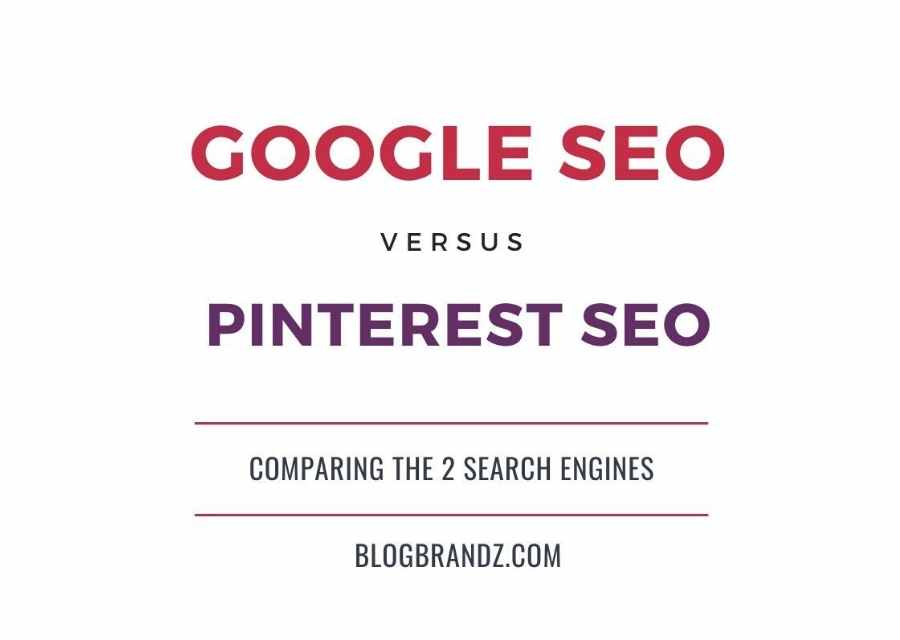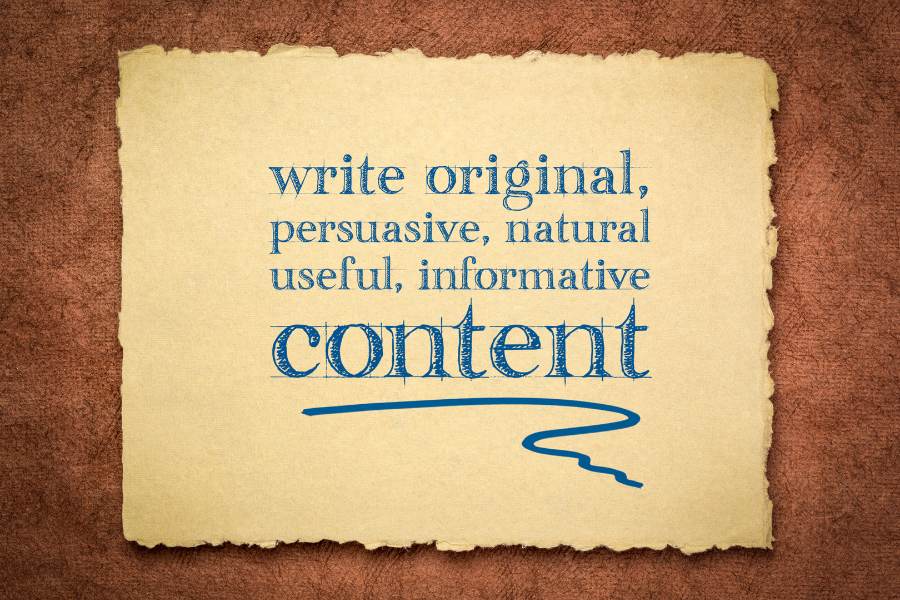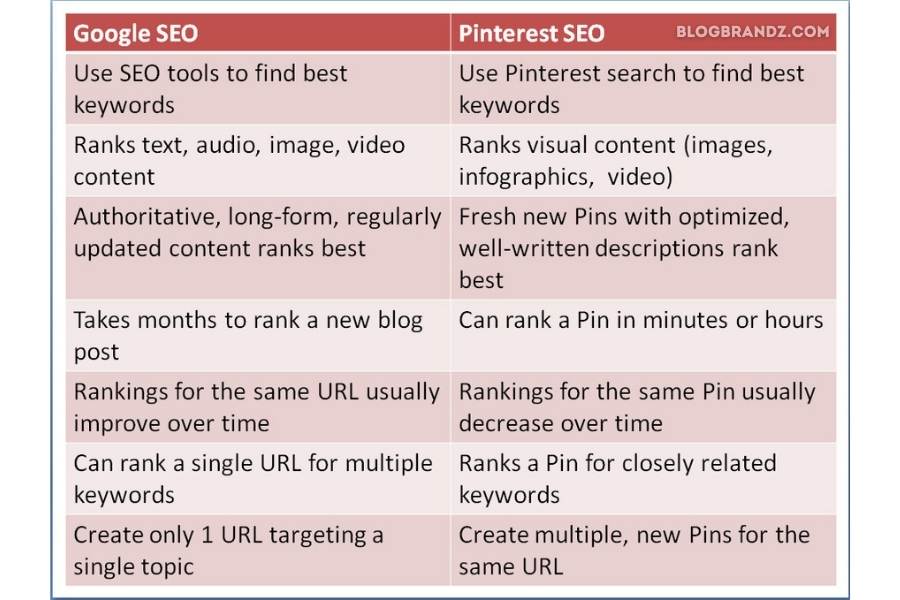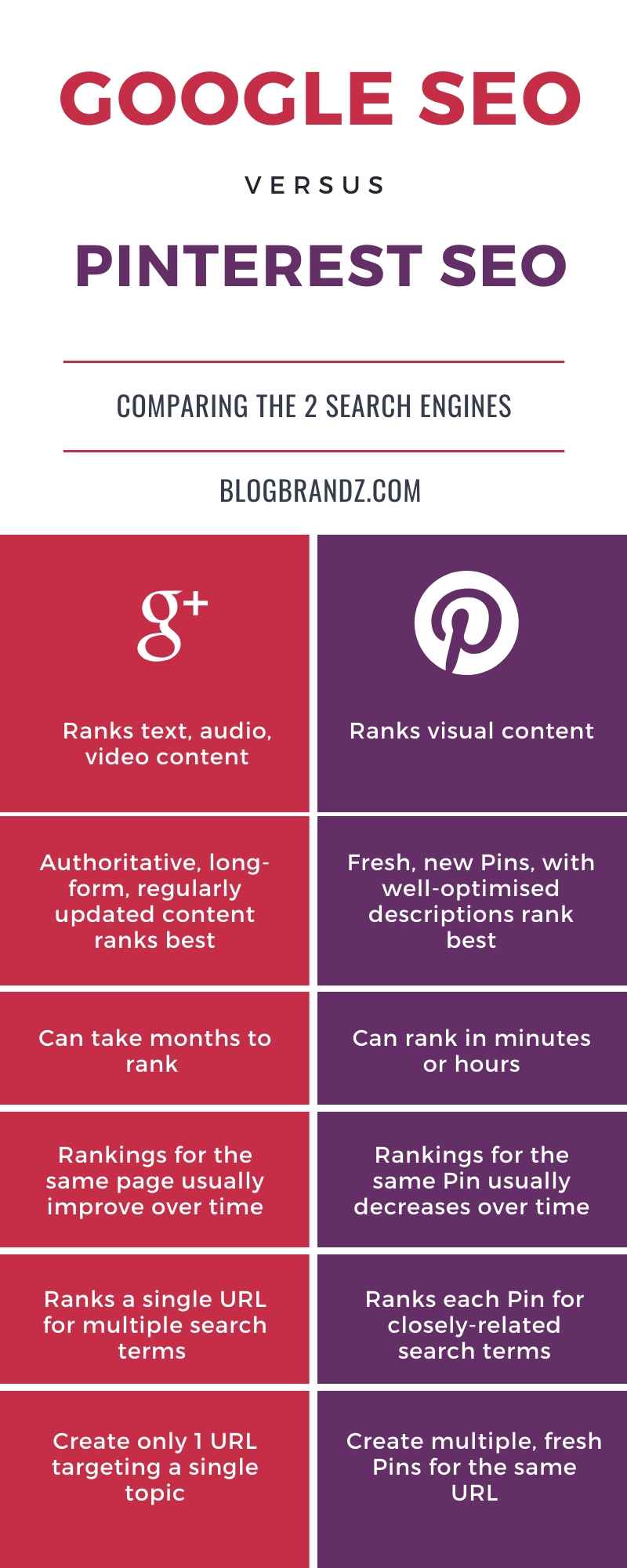
Learn the essential differences between Google SEO and Pinterest SEO to help you boost your search engine ranking on both Google and Pinterest.
SEO is one of the best traffic sources for new bloggers and most focus on building targeted search engine traffic. Google and Pinterest are powerful and popular search engines that can bring in a lot of traffic if you know how to use them.
Leveraging Google SEO and Pinterest SEO for bloggers are very effective ways to increase your search engine visibility and rankings. This article on WordPress SEO for bloggers can help you improve organic Google rankings.
Besides the fact that keywords and user engagement impact rankings on both Google and Pinterest, Google SEO and Pinterest SEO have several significant differences. This means ranking on Google and Pinterest takes a very different set of skills.
In these Pinterest courses for bloggers, you’ll learn how Pinterest works and how to use Pinterest to boost your blog traffic.
Contents
Google SEO Vs Pinterest SEO for Bloggers
This article and the accompanying infographic outline the primary differences between Google SEO and Pinterest SEO to help you boost your search engine ranking on both Google and Pinterest.
#1. Keyword research tools
Unlike Google SEO, where tools like Semrush or Surfer SEO can help you find relevant keywords for blog posts, Pinterest operates as a visual search engine with its own ranking algorithms.
To optimize your Pinterest strategy, utilizing Pinterest-specific keywords is essential for maximizing your content’s reach. You can use Pinterest search or this Free Pinterest Keyword Research Tool to help you find the best keywords for your Pinterest Pins.
Start by typing a broad term related to your content into Pinterest’s search bar. As you type, Pinterest’s autocomplete suggestions display long-tail keywords users actively search for.
These phrases give you valuable insights into what content performs well and can be directly incorporated into your Pinterest Pin titles, descriptions, and boards.
Alternatively, this Pinterest Keyword Research Tool provides search volume and competition data, similar to professional SEO tools for Google.
This allows you to make informed decisions about the keywords to prioritize for SEO-friendly Pinterest pins and increases your chances of ranking higher in searches.
Leverage relevant hashtags and engaging visuals in your Pinterest SEO strategy, as they contribute to user engagement and discoverability.
#2. Type of content
The type of content ranked by search engines differs between Google and Pinterest due to their unique platforms and user experiences.
Google is a multi-format search engine that ranks various content types, including text-based articles, audio (like podcasts), video (such as YouTube content), and images. It considers keyword usage, quality, relevance, and user engagement across these formats.
On the other hand, Pinterest focuses primarily on visual content. It ranks images, infographics, and video Pins based on their relevance to user searches, engagement (clicks, saves), and SEO-driven optimization.
Pinterest emphasizes visually appealing and well-designed Pins, encouraging users to interact with the content. While video is a newer feature on Pinterest, it’s growing in importance, giving creators more opportunities to engage audiences with dynamic, short-form content.
#3. Authoritative vs fresh content
When ranking on Google versus Pinterest, the content strategies differ significantly. Google favors authoritative, long-form content, especially when it demonstrates expertise, trustworthiness, and relevance. Such content is expected to be comprehensive, well-researched, and provide value to the reader.
However, to maintain high rankings, this content must be updated regularly and reflect current trends or information, ensuring it stays relevant. Regular updates and the inclusion of recent data can further enhance its position in search results.
On Pinterest, the focus shifts from authority to freshness. The platform rewards fresh, new Pins over repinned or reused content. This means that continually creating new visual content — whether it’s a fresh image, infographic, or video — is key to maintaining visibility.
While the description still requires proper optimization with relevant keywords, Pinterest prioritizes newly-created Pins that bring fresh engagement, rather than relying on established or long-standing content.
#4. How long it takes to rank
The time it takes for content to rank on Google versus Pinterest varies significantly due to their different algorithms and content strategies. On Google, content ranking can take months. It relies on domain authority, backlinks, content depth, and keyword optimization.
Search engines take time to crawl and index new content, analyze its relevance, and determine where it should rank. Google also factors in user behavior and engagement over time, meaning even highly optimized content may need to build traction before ranking well.
In contrast, Pinterest offers much faster visibility, with content potentially ranking within minutes or hours. This is because Pinterest is primarily a visual discovery platform, and its algorithm is designed to quickly surface fresh, engaging Pins.
Newly optimized Pins can appear in relevant searches immediately, especially if they’re tied to trending topics or high-interest keywords. This makes Pinterest an ideal platform for driving rapid traffic to content, as users can see and engage with your Pins shortly after they’re published.
#5. Rankings over time
The longevity of content rankings differs notably between Google and Pinterest due to their respective algorithms and content lifecycles. On Google, rankings for a well-optimized page generally improve over time, especially if the content remains relevant, authoritative, and continuously updated.
As the page garners more backlinks, traffic, and user engagement, Google rewards this sustained activity, gradually moving the page higher in search results. The more established and trusted a page becomes, the better its ranking tends to perform, often reaching its peak months after publication.
On Pinterest, however, the opposite typically occurs. Rankings for the same Pin usually decrease over time as the platform prioritizes fresh content. While a Pin may rank quickly and perform well in its initial phase, as new Pins are introduced and engagement wanes, older Pins tend to lose visibility.
Pinterest’s algorithm favors new, visually engaging Pins to keep users’ feeds dynamic and up-to-date, making it essential for creators to continually produce fresh content to maintain traffic flow.
#6. How keywords matter
How keywords impact rankings on Google versus Pinterest highlights key differences in their SEO approaches. On Google, a single URL can rank for multiple search terms if the content is well-optimized and covers the topic comprehensively.
Google’s algorithm analyzes the depth and breadth of the content, keyword usage, internal linking, and semantic relevance, allowing a single page to appear in search results for various related queries.
A single piece of content can capture a wider range of search intents by including primary and secondary keywords, with long-tail variations.
On Pinterest, however, the focus is more specific. Each individual Pin is ranked for closely related search terms based on its description, hashtags, and the URL it links to.
Pinterest’s algorithm relies heavily on visual cues and keyword relevance in the Pin’s metadata (description and hashtags) to determine how it appears in search results.
Because of this, creators often make multiple Pins for the same content, each optimized with different keywords or targeting slightly different searches to increase visibility across Pinterest’s search landscape.
#7. Ranking content on the same topic
The approach to content ranking for the same topic differs significantly between Google and Pinterest, affecting how you should strategize your content creation.
For Google, you should create only one URL targeting a single topic. This strategy helps avoid keyword cannibalization, where multiple pages compete for the same keywords, potentially confusing the search engine about which page should be deemed the most authoritative.
By focusing on a single, comprehensive piece of content, you can establish it as a definitive resource on that topic, thereby improving its chances of ranking well.
In contrast, Pinterest allows for a more flexible strategy. You can create multiple, fresh Pins for the same URL, targeting the same keywords. Each Pin can be uniquely designed with different visuals, descriptions, and hashtags while directing users to the same content.
This approach increases the chances of your content being discovered by various audience segments, allowing you to tap into different trends and user interests, maximizing visibility and engagement across the platform.
Here’s a table showing the 7 differences between Google SEO and Pinterest SEO:
I hope this list of differences between Google SEO and Pinterest SEO will show you how to use SEO to boost your visibility and rankings on both these search engines. Learn how to use Pinterest the right way and get advanced Pinterest tutorials and tools to grow your blog traffic.
Get a free trial of the Tailwind App and automatically Pin at the best times for more engagement, reach, and website traffic with one tool. Tailwind is an official Pinterest partner and, on average, members get 6.9X more Repins.
Pinterest tips & tools
- Free Pinterest VA course & best Pinterest bloggers courses
- How to make money on Pinterest for beginners
- Freelance Pinterest careers: How to become a Pinterest manager
- How to grow Pinterest accounts in 2024
- Best ChatGPT prompts for Pinterest marketing
- Why new bloggers should not ignore Pinterest Search
- Pinterest Pin design ideas: How to get your Pinterest Pins seen
- Pinterest Pin design ideas: How to get your Pinterest Pins seen
- Pinterest mistakes hurting your shares & engagement
- Pinterest marketing tips to boost engagement & branding
- How to create a Pinterest marketing strategy that works
Share this Image On Your Site
© 2020 – 2024, Priya Florence Shah. All rights reserved.
Priya Florence Shah is a bestselling author and an award-winning blogger. Check out her book on emotional self-care for women. Priya writes short stories and poetry and chills with her two-legged and four-legged kids in her spare time.
Discover more from Business & Branding Tips
Subscribe to get the latest posts sent to your email.










nice content….!
I totally agree with you. As the saying goes, two heads are better than one.
I really enjoyed reading this post, do you have like pinterest growth course i can purchase?
You’ll find some excellent Pinterest courses here
https://www.blogbrandz.com/tips/pinterest-courses-tools/